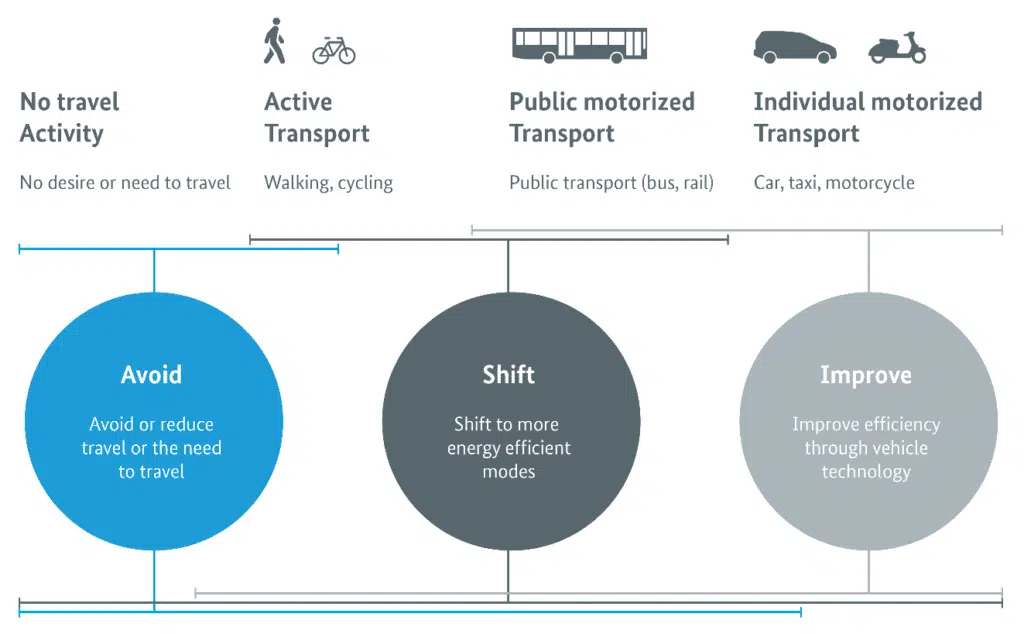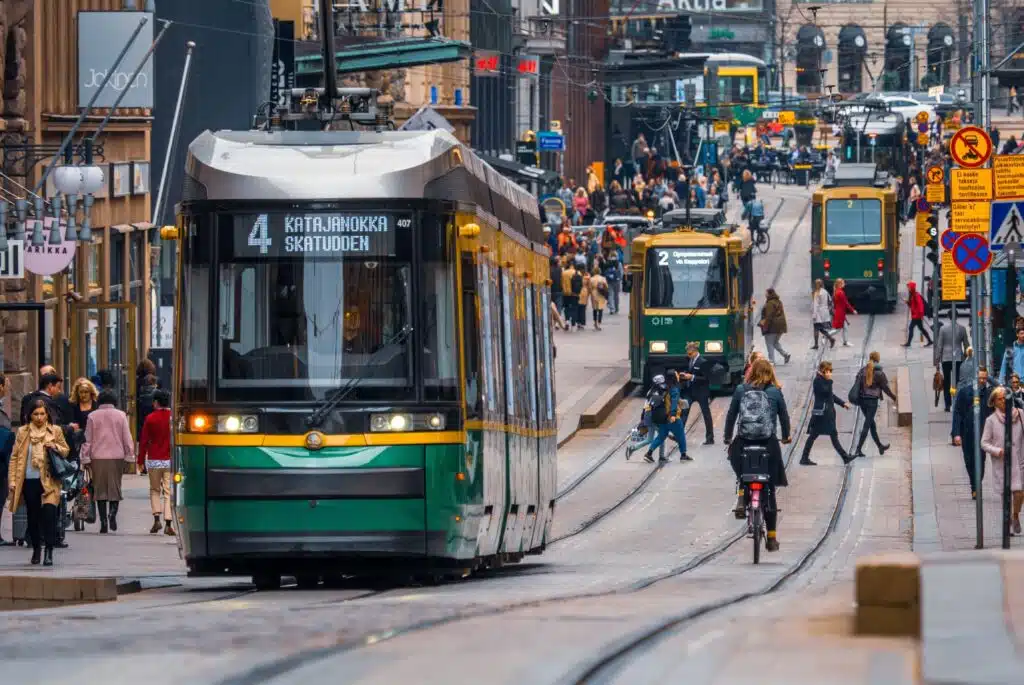(*and as transport planner working for the city)
Mobility is an essential aspect of life. With urbanization rampantly on the rise, cities are the focal points where safe, accessible, efficient, and sustainable mobility is needed for all. Dramatically increasing passenger and freight transport can pose a threat not only to the global climate, but also to the urban environment, citizen health and livability in cities. Mayors and mobility planners will need to work hand-in-hand to solve these challenges and to create mobility systems centered on the needs of people.
This is because cities have a lot to gain from sustainable mobility: in addition to reducing emissions, better connected transport systems provide for healthier people and higher air quality, but fewer road crashes; more jobs and social access, but less congestion; more innovation and inclusion, but less disruption due to climate impacts.
To steer cities towards sustainable mobility and better quality of life, people are key in this transformation. Only high-skilled mobility experts can take charge of the planning and implementation process for successful sustainable mobility. As they address a variety of issues, stakeholders and processes, it is crucial that professionals are equipped with the skills to master these challenges. With this document, we aim to support the development of qualified staff for strengthening sustainable urban mobility.
In consideration of the dynamic development of the transport sector, we provide some insights on required key competencies and areas of expertise for mobility experts in cities. They go beyond core competencies and subjects in transport economics, planning and engineering as well as standard business soft skills which we assume to be increasingly available in city administrations worldwide.

#1 Know what’s right – Avoid – Shift – Improve
The Avoid-Shift-Improve approach is widely acknowledged and an effective strategy to achieve significant greenhouse gas (GHG) emission reductions and decrease congestion in cities. It sets out fundamental guidelines for sustainable urban transport:
- avoiding motorized trips and reducing trip frequencies and distances of all modes,
- shifting individual motorized transport towards public and active mobility modes, and
- improving the energy efficiency, technology, accessibility and safety of the transport system.
Urban leaders and mobility experts, in collaboration with urbanists and other stakeholders, should actively apply the Avoid-Shift-Improve paradigm and support the promotion of the following actions:
Avoid
– Integration of transport and land-use planning
– Development of compact mixed-use city structures to promote active mobility
– Focus on transit-oriented planning to improve development of public transport
– Encouraging telework and mobile offices as well as telecommunication-based education and commerce to reduce the necessity for motorized travel
Shift
– Constantly improving infrastructure, convenience and service level of public transport to provide an alternative to private motor vehicle usage
– Implementation of mass rapid transit systems to give priority to public transport
– Improving infrastructure for pedestrians and cyclists to encourage active mobility and enhance road safety
– Improving law enforcement to deter unlawful use of bus and cycle lanes and improve safety and security of public and active mobility transport users
– Implementation of sharing services in connection to conventional public transport, to provide an alternative to private car ownership
– Introduction of comprehensive transport demand management measures, such as congestion charging and parking management, to incentivize public transport use and discourage private motorized vehicle use
Improve
– Promotion of low carbon emission vehicles, such as battery electric vehicles
– Enhancement of fuel and vehicle efficiency, (e.g. through alternative, climate friendly propulsion technologies), more efficient engines and low rolling resistance tires, limitations and replacement schemes for older vehicles, introduction of emission standards
– Introduction of regular road worthiness and emission testing as well as regular public transport monitoring (usage/reliability/safety)
– Promotion of eco driving to minimize fuel consumption
Keep in mind – typical hindrances for Avoid-Shift-Improve:
Avoid: Lack of coordinated land planning is ubiquitous, and there are always established areas of the city where change is difficult to implement – therefore you should focus on a few target areas and new development as first steps..
Shift: Public transport – especially mass transit – and even NMT facilities either generate insufficient revenue to cover operating costs or no revenue – so plan for the long term. It is necessary to think “outside the box” of infrastructure alone and package developments as part of a system that can generate wider revenue, and be attractive for partial private sector investment.
Improve: Introducing electric vehicles currently often requires coordination and financial support for infrastructure and procurement – so consider where you want to spend your resources to encourage switching (in the short- to medium-term).

#2 Know how to plan – Integrated transport planning and solid financing mechanisms
Mapping the existing formal and informal transport options, including their advantages and disadvantages, is the first task of a sustainable mobility expert. Only by understanding and measuring the existing limitations in public and active mobility, you can start addressing issues such as safety for cyclists, security for public transport users, access to transport services or affordability of public transport comprehensively.
In addition to that, sustainable urban transport experts need knowledge in financing mechanisms. Along with the right prioritization of governmental funding as well as the promotion of development partnerships with the private sector and multilateral development banks, new funding sources, such as international climate finance, can be further pillars of urban transport financing. Transport experts need to know how revenues from fare boxes and revenues from transport demand management measures, e.g. parking fees and congestion charges, can be increased and reinvested in the transport system. Urban leaders should actively encourage the strengthening and diversification of the local resource base. This can entail a wide range of options from parking fees to value capture. Beyond that, urban leaders should support the development of green budgets, assess the “greenness” of current funding and taxation schemes and develop holistic approaches for transport financing and funding.
Project implementation needs proper preparation – mobility experts need to build expertise in project appraisal, tender development and in compiling project applications and build individual and institutional skills for proper preparation of sustainable mobility projects including cost estimates, appraisal of alternatives and quality control.
Keep in mind – typical hindrances for planning and financing:
Investments in projects– especially mass transit, but even NMT facilities – often contain highly visible outcomes and therefore may have an impact on the political agenda of officials. Integrated planning does not stop at electoral time frames, but usually starts before policymakers enter and end after they leave office.

#3 Use adequate active and mass transit solutions – From car friendly to human centered cities
High quality public transport is the fundamental basis for attractive cities. This includes affordable, frequent and reliable service throughout the city. Urban leaders should focus on the continuous improvement of public and active transport (cycling and walking) as well as improvement of public space. Using public transport does not only need to be cheaper than motorized individual transport; it needs to be more accessible and more convenient, too. Transport planners and decision-makers must work towards removing the perception that active and public transport is only for poorer people.
Integration of individual modes of urban transport is essential to increase the competitiveness of urban public and active transport compared to private car usage. This means urban leaders should also initiate robust strategies to reduce the demand for individual motorized transport and prioritize walking and cycling as the easiest options. As road space ultimately is limited, this is just another precondition for seamless, efficient, easily accessible, safe and affordable mobility.
Comprehensive public and active mobility planning are vital for a successful urban mobility strategy. Expertise in the field of non-motorized and mass transit solutions is crucial for successful transport planners. In addition, a strong managerial and planning focus on user-friendliness, public transport promotion, and integrated organization of public transport is required and should be underpinned by sound institutional structures and funding.
As a response to continuously evolving mobility behavior, new mobility services can also re-focus the conversation on people in cities. Micromobility through shared bikes and scooters, car-sharing and last-mile ride-hailing are exemplary services, which can reduce dependence on private car usage and encourage a lifestyle that does not focus on owning a private vehicle – keep track of those developments.
Keep in mind – typical hindrances for human cities:
It can happen easily to city administrations and mobility providers that they forget the ultimate user they are serving by focusing too much on technical or structural issues. Integrating users into the design of your projects or infrastructure from the beginning is therefore very important.
You also need to recognize that provision of space for active modes will require re-allocation of right-of-way, very likely from vehicles. This will require advocacy efforts along with a good communications strategy to minimize the potential negative challenges.

#4 Embrace innovations – Digital and behavioral innovations shape the potential of mobility in your city
New shared mobility services and digitalization can initiate a transformational change towards car independent urban areas and more livable, socially responsible and competitive cities. With the rise of smartphone adoption and mobile applications as a key to disruptive behavioral changes in the transport sector, transport planners and policy-makers have to adopt these new digital tools to accelerate a shift from the automobile-oriented city to a low carbon urban transport system. This requires a clear vision and framework on how innovation in sustainable mobility can contribute to improved access to jobs and opportunities for people.
Against the background of technological progress and legal uncertainty, decision-makers should avoid reacting with restrictive and overregulating policies, which can pose major hurdles for new transport solutions. At the same time, new mobility innovations driven by the private sector, should be assessed against publicly set targets and benchmarks regarding quality and safety, to lead to good outcomes for and shape the future mobility of the city.
Mobility experts should recognize that a rapidly increasing number of consumers adopt information and communication technology (ICT) based transport options. This is an opportunity for the city to explore the benefits and downsides of ICT-based mobility and promote it by shaping an adequate policy environment. Here, policy-makers and legislators should support cities with resources and staff to monitor and integrate private sector mobility into public service offers.
In addition to stimulating innovation and private investment in the transport sector, local authorities should provide and request open data access. Mobility service providers in the region should be obliged to make their data available to the public sector in order to improve the integration of all modes of transport. Integration of information and billing services is equally important to promote an inter- and multi-modal mobility behavior. This also involves enhancing the connectivity of technological, digital and institutional platforms to achieve synergies in the low carbon transport sector.
Keep in mind – typical hindrances for digital and behavioral innovations:
Where to find adequately trained staff? As the subject is evolving quickly, urban leaders should encourage flexible management structures attracting bright talents and young professionals from various backgrounds. Team members with experience in new mobility can help to identify, assess and accompany the introduction of new solutions to mobility planning.
New work and leadership concepts may also play a role if your city aims to manage and regulate a well-paying private sector. After all, not all innovations may be aligned with your city’s strategy, and therefore should be evaluated and authorized based on their contribution to the public authorities’ goals. At the same time, you should not attempt to crowd out innovative ideas from private and civic stakeholders.

#5 Talk, report, share – Cross-departmental coordination and performance-based management
In the decision process on how to tackle the growing demand for transport as well as the related climate, environment, economic and social challenges, urban leaders need to involve a broad range of interdisciplinary responsibilities. The relevant issues concern decision-makers and legislators for transport, energy, environment, science, digitalization and/or industry. Therefore, it is necessary to establish and maintain dialogue between the relevant departments. In such platforms or institutionalized discussions, where decision-makers and technical experts from various departments and institutions of all levels discuss and decide town planning holistically, people will be able to share success stories beyond their own spheres. Public communication strategies are also necessary to include the concerned non-state stakeholders (e.g. from academia, industry and civil society) in the discussion on how to transform urban transport. Having expertise in communications and negotiation skills therefore is a crucial quality for local authorities and their mobility.
The setting of overall targets as well as an indicator-based evaluation of implemented measures is an essential step to designing a roadmap for sustainable urban transport. Targets should be pragmatic, measurable, comprehensible and motivating. They can be incorporated in an overall urban development strategy and/or sustainable urban mobility plans and serve as data basis for target-oriented policy-making and transport planning. Sustainable mobility experts should know how to use appropriate management tools to evaluate the implementation processes, e.g. MRV (measure, report, verify) procedures. Such tools may also facilitate near-term strategy adjustment as well as long-term strategy orientation. In addition, the transparent monitoring and evaluation of GHG mitigation impacts is a requirement to access local, national and international (climate) finance and funds of multilateral development banks.
Keep in mind – typical hindrances for cross departmental coordination and management:
Typically, different departments competing for resources may find it difficult to join forces on a project base. However, instead of focusing on differences, you may benefit by developing a comprehensive communications strategy to convey positive messages to the public – rather than being reactive when problems arise. Apart from communication just among experts, or in one direction, it will also be beneficial to involve stakeholders in planning and implementation and to involve non-official experts and regular citizens as well as the ‘usual suspects’.
Summary
The dynamic development and transformational challenges that we observe in the mobility sector require high aspirations, strong forward-thinking institutions as well as the continuous development of capacities and competencies among policy-makers, regulators and planners. Traditional transport planning is undergoing a revolution characterized by new challenges, new drivers of innovations as well as new mobility demands. Everybody governing a city should pay attention to the following principles and skills:
– Integration of transport services is the goal, integration of transport modes, agendas and institutions is the means.
– Thorough knowledge of national and international financing mechanisms, project preparation and monitoring and evaluation skills will be essential for the implementation of new sustainable mobility infrastructure.
– Decision-makers and mobility experts need to explore the potential of emerging mobility trends and embrace new future-oriented opportunities to promote low carbon transport.
– Mobility experts must join forces and create alliances with their peers in other departments and sectors.
The continuous development of individual and organizational skills in the mobility sector is a huge task – we as TUMI are happy to join this effort and to offer our resources and skills.
”We have the power to move the world” – New publication by C40 Cities and TUMI
Rethinking how we move around our shared spaces is central to transform mobility in your city.
From offering free public transport during rush hour and tax discounts to electric cars, to building green corridors through public cycling systems, introducing bus rapid transit systems, and expanding pedestrian only zones, decisive action is already making a difference in cities around the world.
Together with TUMI partner C40 Cities, we published a mayors’ guidebook on sustainable transport. In “We have the power to move the world”, the leaders of 14 of the world’s most ambitious and successful cities explain why they are taking action, what they are implementing, the approaches they are taking, and their advice for other cities.
More information on https://www.transformative-mobility.org/publications/we-have-the-power-to-move-the-world-a-mayors-guidebook-on-sustainable-transport
This guidebook is meant to give you, as mayors, the opportunity to learn directly from your peers on how to implement the projects needed to achieve this goal. All cities and mayors featured have shown bold political leadership, which we hope can serve as an inspiration for you to show the same leadership in your cities.
Click here for an Arabic translation of this guidebook.

